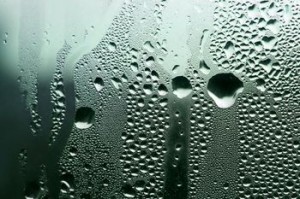Condensation On Windows:

Can you draw hearts and smiley faces with your fingers in the condensation on the inside of your windows? If so, don’t blame your windows. High humidity in the home often causes “sweating” on windows.
Condensation is a natural occurrence on all surfaces in the home caused by excess humidity in the air. When water vapor comes in contact with a surface which has a cooler temperature (like a window), the vapor turns into visible droplets of moisture, which can be seen on the glass. This water vapor also adheres to the walls, which can be a more serious problem because it can penetrate walls and potentially cause mold or mildew buildup.
Understanding Condensation on Windows
Where is this condensation coming from in your home? According to the Window and Door Manufacturers Association, normal breathing and perspiration by a family of four adds a half pint of water to the air in the home each hour. That’s more than six quarts of water a day. Steamy showers add another half pint. Boiling water for pasta and other cooking activities can add up to four or five pints of water per day to your home. And, dishwashers, washing machines and even dryers can add several more pints of water to the air. Even poorly-insulated crawl spaces allow humidity to penetrate the house.
Windows and Water
Seeing condensation build-up on your window signals that steps need to be taken to reduce condensation in the home. When you have energy-efficient windows, the temperature of the glass helps reduce condensation buildup, but it will not prevent the buildup. “Although there’s no such thing as a condensation-free window in high humidity conditions, insulating glass units really help reduce condensation,” says Christopher Burk, product manager for Simonton Windows. “Some thermally-efficient windows resist condensation better than others. Homeowners should look for windows with the highest R-values possible along with the lower U-values. R-value is the resistance a material has to heat flow. And, U-values give better insulating quality. Together, that means a more condensation-resistant window.”
Reducing Moisture in the Air
All homes need some moisture, but not an excessive amount. If you notice condensation on your windows or walls, try these tips to reduce the moisture in your home:
Tip #1 – Regularly use ventilation fans in bathrooms, kitchens and laundry rooms to circulate the air.
Tip #2 – Air out your home frequently by opening doors and windows to circulate airflow.
Tip #3 – Reduce your number of indoor house plants, since plant increase humidity levels.
Tip #4 – Add a dehumidifier to your home to remove excess moisture from the air.
Tip #5 – Make sure you have working vents in your attic, basement and crawl spaces.
“It’s important to remember that windows don’t cause condensation,” says Burk. “If there are high humidity conditions in your home, the windows are acting as a barrier to prevent the moisture from escaping the home. So, solve the moisture problem in the home and you’ll help reduce the condensation.”
Keeping Condensation Outdoors
While condensation on the inside of your windows indicates a problem in the home with high humidity levels, the opposite is true when condensation is on the outside of your windows. “When you see condensation on the outside of your windows, this means the insulating glass unit is doing its job — insulating your home from the rain, moisture and other environmental conditions you want to keep on the outside,” says Burk. “The best aspect of double- or triple-glazed windows is that they act as a barrier against temperature extremes. They help save on energy bills and keep the home warmer in the winter and cooler in the summer.”
Burk offers a final tip for homeowners related to replacing windows. “Sometimes homeowners will see more condensation on recently-replaced energy efficient windows than on their old windows,” says Burk. “That’s because their old windows were probably drafty and the moisture was escaping through the small air gaps. Once the home has more energy-efficient windows in place, the humidity is ‘locked in’ the house and doesn’t escape through the cracks. Make no mistake … the energy-efficient replacement windows are far better for the home and energy bills than leaky windows. It just means that homeowners need to be more vigilant about reducing the humidity levels in the home.”

